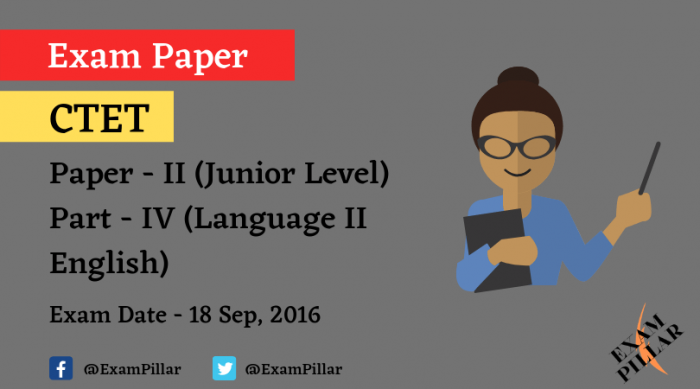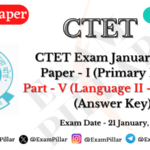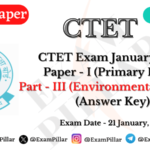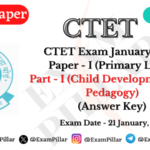CBSE conducted the CTET (Central Teacher Eligibility Test) Exam Paper held on 18th September 2016 Morning Shift. Here The CTET Language II English Solved Question Paper II (Class VI to VIII) Answer-key.
CTET (Central Teachers Eligibility Test) Paper Second : Junior Level (Class 6 to Class 8).
Exam : CTET Paper II (Class VI to VIII)
Part : Language II (English)
Organized : CBSE
Number of Question : 30
Paper Set – II
Exam Date – 18th September 2016
Read Also…
- CTET Sep 2016 Paper -II – Part – I – बाल विकास और शिक्षा-शास्त्र (Child Development and Pedagogy)
- CTET Sep 2016 Paper -II – Part – III – सामाजिक अध्ययन / सामाजिक विज्ञान (Social Studies/Social Science)
- CTET Sep 2016 Paper -II – Part – IV – Language – I (English)
- CTET Sep 2016 Paper -II – Part – IV – Language – I हिंदी (Hindi)
- CTET Sep 2016 Paper -II – Part – V – Language – II हिंदी (Hindi)
CTET Exam September 2016 Paper – 2 (Junior Level)
Part – IV (Language II – English)
Directions : Answer the following questions (Q. Nos. 1 to 5) by selecting the correct/most appropriate options.
1. When children are introduced to English as a second language :
(1) they should read first
(2) they should begin with letters of the alphabet
(3) they should be exposed to language orally
(4) they should begin writing first
Show Answer/Hide
2. Eclecticism in language teaching refers to using :
(1) all the methods to teach language
(2) appropriate strategies from various methods of teaching
(3) the best method of teaching
(4) technology to teach language
Show Answer/Hide
3. Which of the following approaches/ methods advocates linguistic competence and performance?
(1) Communicative approach
(2) Grammar-translation method
(3) Direct method
(4) Structural approach
Show Answer/Hide
4. Global listening is not listening :
(1) for specific information
(2) without being constrained by preset questions or tasks
(3) at different levels of comprehension
(4) for improving recognition of spoken text
Show Answer/Hide
5. Which of the following activities needs to be taken care of for helping non-native speakers to produce the sounds of the target language?
(1) Distinguishing the vowel from consonant sounds
(2) Imitating the way a native speaker produces sounds
(3) Ensuring that the words spoken are intelligible to others
(4) Maintaining the regional interference
Show Answer/Hide
6. The concept of trans formative generative grammar was given by :
(1) Bruner
(2) Ferdinand Saussure
(3) Noam Chomsky
(4) Piaget
Show Answer/Hide
7. Tail question also refers to :
(1) follow-up question
(2) question tag
(3) insignificant question
(4) most important question
Show Answer/Hide
8. A teacher of Class VII while teaching the poem, The Solitary Reaper by William Wordsworth asks children to find how the last words of each line sound. What is she trying to draw the attention of learners to?
(1) Theme of the poem
(2) Spelling of words
(3) Rhyme scheme
(4) Vocabulary
Show Answer/Hide
9. To help the students overcome the problems of spelling mistakes, the teacher will use _____ as the teaching strategy
(1) loud reading
(2) brainstorming
(3) pronunciation drill
(4) dictation
Show Answer/Hide
10. Grammar-translation method of teaching English heavily relies on:
(1) form-focussed teaching
(2) meaning-focussed teaching
(3) direct teaching as a strategy for learning
(4) language use as the main focus
Show Answer/Hide
11. Language proficiency refers to :
A. fluency
B. accuracy
C. appropriateness
D. efficiency
Which of the above are true?
(1) A, B and D
(2) A, B and C
(3) B, C and D
(4) A, C and D
Show Answer/Hide
12. Written description of a child’s progress that a teacher keeps on a day-to-day basis is :
(1) rubric
(2) anecdotal record
(3) portfolio
(4) rating scale
Show Answer/Hide
13. A teacher of Class VI in a writing assessment task asked students to write on : “If I were famous for something ____”. This is assessment of a/an – answer.
(1) narrative
(2) extrapolative
(3) factual
(4) descriptive
Show Answer/Hide
14. A good language textbook should :
A. contain learner-centred materials
B. contain teacher-friendly instruction and content-related materials
C. incorporate language skills throughout
D. have more syntactical items in its content
Which of the above are true?
(1) B, C and D
(2) A, B and C
(3) A, B and D
(4) A, C and D
Show Answer/Hide
15. Kavya notes down the errors committed by learners of the class and discusses them once in a fortnight. What is this practice known as?
(1) Providing feedback
(2) Evaluation
(3) Assessment
(4) Error correction
Show Answer/Hide




